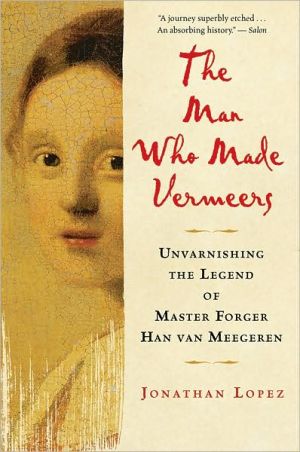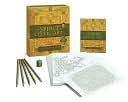The Man Who Made Vermeers: Unvarnishing the Legend of Master Forger Han van Meegeren
It's a story that made Dutch painter Han van Meegeren famous worldwide when it broke at the end of World War II: A lifetime of disappointment drove him to forge Vermeers, one of which he sold to Hermann Goering in mockery of the Nazis. And it's a story that's been believed ever since. Too bad it isn't true.\ Jonathan Lopez has drawn on never-before-seen documents from dozens of archives to write a revelatory new biography of the world’s most famous forger. Neither...
Search in google:
It's a story that made Dutch painter Han van Meegeren famous worldwide when it broke at the end of World War II: A lifetime of disappointment drove him to forge Vermeers, one of which he sold to Hermann Goering in mockery of the Nazis. And it's a story that's been believed ever since. Too bad it isn't true.Jonathan Lopez has drawn on never-before-seen documents from dozens of archives to write a revelatory new biography of the world’s most famous forger. Neither unappreciated artist nor antifascist hero, Van Meegeren emerges as an ingenious, dyed-in-the-wool crook—a talented Mr. Ripley armed with a paintbrush. Lopez explores a network of illicit commerce that operated across Europe: Not only was Van Meegeren a key player in that high-stakes game in the 1920s and '30s, landing fakes with famous collectors such as Andrew Mellon, but he and his associates later cashed in on the Nazi occupation.The Man Who Made Vermeers is a long-overdue unvarnishing of Van Meegeren’s legend and a deliciously detailed story of deceit in the art world.Publishers WeeklyIn this engaging study, art historian Lopez examines-as did Edward Dolnick's Forger's Spell, published in June-the fascinating case of Han van Meegeren, a notorious Dutch art forger. Van Meegeren, who sold Hermann Goering a fake Vermeer, was convicted of collaboration; he became a folk hero for duping the Nazi leader. But according to Lopez, van Meegeren was a successful forger long before WWII, and contrary to van Meegeren's claim that he was avenging himself on the art critics who had scorned his own work, Lopez says he was motivated by financial gain and Nazi sympathies: "What is a forger if not a closeted Übermensch, an artist who secretly takes history itself for his canvas?" Lopez asks provocatively. The author gives a vivid portrait of the 1920s Hague, a stylish place of "mischief and artifice" where van Meegeren learned his trade, and brilliantly examines the influence of Nazi Volksgeist imagery on van Meegeren's The Supper at Emmaus, part of his forged biblical Vermeer series. Lopez's writing is witty, crisp and vigorous, his research scrupulous and his pacing dynamic. 88 b&w photos. (Sept.)Copyright © Reed Business Information, a division of Reed Elsevier Inc. All rights reserved.
Chapter One\ The Collaborator\ THEY CAME FOR HIM on May 29, 1945. Shortly after 9:00 in the evening, Lt. Joseph Piller walked over to Keizersgracht 321 from his nearby headquarters on the Herengracht. An armed soldier was by his side. They had a car at their disposal—one of the few working vehicles in the city—but tonight they had no intention of using it. They planned to conduct Han van Meegeren to Weteringschans Prison on foot, marching him through the streets at the point of a gun.\ It was cool and damp in Amsterdam; it had rained on and off all day. Complete darkness had settled upon the city: there were no street lamps, no house lights, no bright points of illumination shining down from apartment windows. The electricity and gas had been shut off throughout the Dutch capital for months. Having promised to lead occupied Holland into a glorious new era under his rule, Hitler had instead plunged it back into the age of the candle and the kerosene lantern. Even with the Germans now defeated, the power grid wouldn’t be up and running again for weeks; gas service wouldn’t return to normal until the winter. And of course there had been other, more serious indignities visited upon the Dutch people that could never be set right at all.\ Knocking on the front door of Van Meegeren’s home, an elegant, centuries-old burgher’s residence, Lieutenant Piller announced himself as an officer of the provisional military government, or Militair Gezag. Once the introductions were dispensed with, matters took their natural course. The silver-haired Van Meegeren, a small man with a theatrically large presence, expressed complete bewilderment at Piller’s inquiries into Hermann Goering’s seemingly looted Vermeer. And with regard to the five other biblical Vermeers that Lieutenant Piller had traced back to him, Van Meegeren was likewise unable to provide further particulars. Piller then asked how, exactly, Van Meegeren had gotten so rich amid the widespread deprivations of the war. "He said that he had sold a group of Flemish Primitives prior to the outbreak of hostilities," Piller noted in his statement for the case file, "and that it was in this way that he had come by his money." Having already interviewed enough people to know better, Lieutenant Piller wasted no time informing Van Meegeren that the game was over.\ As Van Meegeren later described it, he remained stoic and inscrutable throughout the mile-long journey to the Weteringschans. If true, this was no mean feat: collaborators on their way to jail were often jeered at or accosted by angry bystanders, even at night, now that curfews had been abandoned. In the three weeks since the end of the war in Europe, the public humiliation of quislings had become victory’s sideshow. Thousands of -German-friendly Dutchmen were being led off to prison all across the country, sometimes one by one and sometimes in large groups, stumbling along with their hands clasped behind their necks, their faces frozen with fear.\ During the war, the Germans had used Weteringschans Prison as a way station for Amsterdam Jews picked up in night raids, or razzias. Anne Frank’s family had been kept there before being sent on to the death camps. Located just a stone’s throw from the Rijksmuseum, in the center of the city, it was a convenient place for the Gestapo to take care of the record keeping so important to their far-flung apparatus of murder. Resistance leaders had also been held at the Weteringschans; some had been tortured there; some had been put to death. That this hulking, high-walled, nineteenth-century jail was now filling up with the Nazis’ friends and helpers was a kind of poetic justice—inadequate, to be sure, but gratifying nonetheless.\ When they finally arrived at the prison, Lieutenant Piller gave Van Meegeren one last chance to tell the truth, instructing him to write down the names of the people who had provided him with the Vermeers.\ "They tried to get me to talk," Van Meegeren later recalled, "but they did not succeed."\ His stubbornness earned him a stay in solitary confinement. The guards shut him away sometime after 11:00 that night—and Lieutenant Piller, for his part, would have been content to let Van Meegeren rot in the Weteringschans forever.\ JOSEPH PILLER WAS neither a professional soldier nor an expert in the history of art. He didn’t understand the full details of Van Meegeren’s case, and many of his assumptions about what had occurred would later turn out to be wrong. But Piller approached this matter, like everything else he was working on in those chaotic days just after the Liberation, with a sense of passion and purpose. "It was clear that I didn’t like collaborators," he later remarked. "Too much had happened in my life to be kind to people like that. I was more extreme then. I was young and had witnessed many deaths, and I hated anyone who had worked with the Germans."\ A self-described "simple Jewish boy," Joseph Piller had been living happily in Amsterdam until May 1940, when the Germans invaded the Netherlands. He soon found it expedient to take refuge in the countryside with his wife and infant daughter. A skinny twenty-six year old, a garment worker by trade, Piller had no prior experience with rural life, but he made the most of his time among the farms and fields of the tiny village of Emst. He joined the local Resistance and set to work finding hiding places for Jewish children from the cities: locating reliable farmers who could take on young "guests"; procuring false identity papers and ration cards through clandestine channels; raiding German storerooms for supplies; and keeping a constant eye out for the unwelcome attention of informants. This network was fully established and running smoothly when the admirable Piller suddenly found himself with additional responsibilities one day in 1942, when a British secret agent named Dick Kragt fell from the sky bearing special orders from London. Kragt had parachuted into the Netherlands on a mission to rescue Allied airmen shot down over occupied territory—to hide them, protect them, and then spirit them across the front lines to safety. And, together, Kragt and Piller proceeded to do just that, time and again, over the next two and half years, expanding the Underground’s existing operation to accommodate the new assignment.\ By the time he came face to face with Van Meegeren, Piller had been awarded an officer’s commission in the newly reconstituted Dutch army. Indeed, he had assumed a leading role in investigating the goings-on at Amsterdam’s famed Goudstikker gallery. A Jewish-owned business, the gallery had been taken over shortly after the invasion by one of Hermann Goering’s henchmen, a -Bavarian banker named Alois Miedl. Known throughout the war years as the go-to man for German opportunists visiting the conquered Dutch capital, the chubby Miedl whiled away his evenings with the fast set of young Nazi officials who congregated at the bar of the sumptuous Amstel Hotel; he threw dinner parties for the likes of Ferdinand Hugo Aus der Fünten, the SS Hauptsturmführer in charge of transporting Dutch Jews to the death camps of Eastern Europe; and when VIPs came to town from Berlin, Miedl proudly led them on tours of the storerooms of looted Jewish valuables—silverware, furniture, porcelain, watches, wedding rings, children’s toys. Lieutenant Piller, as he informed Allied investigators at the time, was convinced that Miedl had turned the Goudstikker gallery into a front where looted art got laundered into cash to finance the Nazis’ Abwehr espionage ring. Given Miedl’s well-timed escape to the safety of Falangist Spain toward the end of the war, such a theory seemed more than credible. Piller was after big game: spies, informers, the hidden financial workings of the Third Reich. It was in the course of looking into these matters that he happened upon the Van Meegeren case.\ "I discovered that a painting had passed through Miedl’s hands depicting Christ and the Adulteress, attributed to Johannes Vermeer," Piller stated in a later deposition. "Miedl bought it for 1.65 million guilders and then sold it to Hermann Goering. By interviewing various middlemen I realized that this work must have come from the artist Han van Meegeren.Speaking to various other people, I soon discovered that a total of six paintings by Johannes Vermeer had appeared on the market since 1937 and that these also had come from the aforementioned Van Meegeren. I then went to Van Meegeren for an explanation."\ But Van Meegeren was clearly not the type to explain. The man was a collaborator—Piller was quite sure of it—and like all collaborators, Van Meegeren had covered his tracks. Although Piller could link him to the Vermeers through various dealers and straw men, the trail went cold from there. The experts whom Piller consulted said that these particular Vermeers were part of a special cycle of paintings, unusual for their biblical subject matter. It was thought that Vermeer might have painted them to decorate a schuilkerk, a hidden Catholic church, during the Reformation. If these pictures had originally belonged together, then it stood to reason that Van Meegeren and his accomplices might have looted all of them from a single collection. But which one, where—and who else was involved?\ On June 11, 1945, Piller transferred Van Meegeren from the Weteringschans to a nearby interrogation facility on the Apollolaan. There, Piller and his men questioned Van Meegeren for an entire day, around the clock, without pause. Van Meegeren admitted to nothing: when asked a question, he would either turn away and face the wall or else answer with an elaborate non sequitur.\ Piller then decided to try a more aggressive tactic. He told Van Meegeren that the Allies had tracked down Miedl in Spain—which, in fact, was true. Piller then suggested that Miedl was prepared to testify under oath that Van Meegeren had come to the Goudstikker gallery with the sole intention of doing business with highly placed Germans, a threat that Piller invented out of thin air. If Van Meegeren refused to divulge the names of his accomplices, Piller could still get him for trading with the enemy—even without an admission of guilt—on the basis of Miedl’s supposed testimony.\ Piller asked Van Meegeren one last time where Hermann -Goering’s Vermeer had come from.\ "He turned to me," Piller recalled, "and he said: ‘I did it. I painted it.’"\ For perhaps the first time in his life, Han van Meegeren was being entirely honest. And to Joseph Piller’s everlasting astonishment, he found himself believing Van Meegeren’s confession almost immediately. "I was sure of it," Piller later observed. "Van Meegeren had done it. It was completely in keeping with human nature. He was someone who felt misunderstood by everyone involved with art. He wanted to show the world what he could really do.After twenty-four hours of questioning, once you came to understand his psychology, it made perfect sense."\ Indeed it did. And suddenly, Joseph Piller, who had just come through his own five-year David-and-Goliath struggle, saw something in Han van Meegeren that he rather liked.\ Copyright © 2008 by Jonathan Lopez\ All rights reserved. No part of this publication may be reproduced or transmitted in any form or by any means, electronic or mechanical, including photocopy, recording, or any information storage and retrieval system, without permission in writing from the publisher.\ Requests for permission to make copies of any part of the work should be submitted online at www.harcourt.com/contact or mailed to the following address: Permissions Department, Houghton Mifflin Harcourt Publishing Company, 6277 Sea Harbor Drive, Orlando, Florida 32887-6777.
Introduction A Liar's Biography 1Ch. 1 The Collaborator 11Ch. 2 Beautiful Nonsense 21Ch. 3 The Sphinx of Delft 52Ch. 4 Smoke and Mirrors 72Ch. 5 A Happy Hunting Ground 100Ch. 6 The Master Forger and the Fascist Dream 124Ch. 7 Sieg Heil! 143Ch. 8 Goering Gets a Vermeer 166Ch. 9 The Endgame 186Ch. 10 Swept Under the Rug 221Epilogue: Framing the Fake 243Acknowledgments 249Endnotes 257Select Bibliography 295Picture Credits 317Index 323
\ Publishers WeeklyIn this engaging study, art historian Lopez examines-as did Edward Dolnick's Forger's Spell, published in June-the fascinating case of Han van Meegeren, a notorious Dutch art forger. Van Meegeren, who sold Hermann Goering a fake Vermeer, was convicted of collaboration; he became a folk hero for duping the Nazi leader. But according to Lopez, van Meegeren was a successful forger long before WWII, and contrary to van Meegeren's claim that he was avenging himself on the art critics who had scorned his own work, Lopez says he was motivated by financial gain and Nazi sympathies: "What is a forger if not a closeted Übermensch, an artist who secretly takes history itself for his canvas?" Lopez asks provocatively. The author gives a vivid portrait of the 1920s Hague, a stylish place of "mischief and artifice" where van Meegeren learned his trade, and brilliantly examines the influence of Nazi Volksgeist imagery on van Meegeren's The Supper at Emmaus, part of his forged biblical Vermeer series. Lopez's writing is witty, crisp and vigorous, his research scrupulous and his pacing dynamic. 88 b&w photos. (Sept.)\ Copyright © Reed Business Information, a division of Reed Elsevier Inc. All rights reserved.\ \ \ \ \ The Chicago TribuneLopez . . . .extensively discusses Van Meegeren's 1920s apprenticeship with restorer/forger Theo van Wijngaarden (skated over by Dolnick, who prefers to see the artist as a buccaneering individual). Lopez delves into the interactions among shady art dealers, crooked businessmen and experts who were sometimes betrayed by corrupt associates coaching the forgers to appeal to their preconceptions. He shows the wealthy American collectors and dealers who were their initial marks becoming increasingly wary as some of Van Meegeren's 1920s fakes were exposed . . . .\ \ Those with a more serious interest in the subject . . . will close Dolnick's book with an uneasy feeling that it leaves out a lot, an impression amply justified by perusal of Lopez's more detailed and thoughtful work in "The Man Who Made Vermeers."\ \ \ Harvard Magazinean astonishing tale\ \ \ \ \ The Washington TimesArt historian Jonathan Lopez has now raised the bar for any future books on the forger with "The Man Who Made Vermeers.\ \ \ \ \ Salon.comOne of the most audacious careers in the annals of art fraud - a journey superbly etched by Jonathan Lopez in his absorbing history "The Man Who Made Vermeers.\ \ \ \ \ The New York SunIn his thoughtful and elegantly written account - which he calls "a liar's biography" - Jonathan Lopez gives the story unexpected depth. Van Meegeren is exposed not merely as an unprincipled peddler of phony masterpieces but as an opportunist with Nazi convictions . . . .Mr. Lopez is steeped in the literature of the period and it shows to fine effect.\ \ \ \ \ The Compulsive ReaderA wonderful book and perfectly done.\ \ \ \ \ Kirkus ReviewsArt journalist Lopez shows a Dutch painter who enriched himself by faking Old Masters emerging as a folk hero at the end of World War II. Not much of a hero, the author convincingly demonstrates in his closely argued and generously illustrated debut. Han Van Meegeren was a sorely sullied character at best, a perfidious crypto-fascist and Nazi collaborator at worst. A longtime art forger (he'd begun with fakes of Franz Hals), he married twice, dallied often, lived like a prince in occupied Amsterdam while his fellow citizens starved in the streets, sent felicitations to Hitler, painted pro-Aryan images, lied, manipulated old friends and betrayed both calling and country. Lopez meticulously reconstructs the edifice of Van Meegeren's life. We learn about his parents, his education and training, his early leftist leanings and his eventual relationship with the right. Because his portrait paintings didn't enable him to live in the style to which he hoped to become accustomed, he soon embraced forgery, inventing new techniques that fooled experts (chemists included) and employing to his advantage a lacuna in Johannes Vermeer's biography. Van Meegeren knew that Vermeer had done some early paintings with religious themes, so he decided to plug the gap with more. For a few years he fooled the art establishment. Collectors and museums bought his Vermeers and displayed them proudly and prominently; rapacious art lover Hermann Goering ponied up mega-guilders for the bogus Christ and the Adulteress. Although Van Meegeren was quickly nabbed after the war, he convinced arresting officer Joseph Piller that he'd been duping the Nazis, not collaborating with them. Piller became a friend and advocate; thepress loved the story. Van Meegeren eventually was convicted of forgery and sentenced to a year in prison, but he died before serving a day. First-rate research and narrative skill propel this tale of greed, war and skillful manipulation of the popular imagination. For more, see also Edward Dolnick's authoritative The Forger's Spell (2008). Agent: Rob McQuilkin/Lippincott Massie McQuilkin\ \








